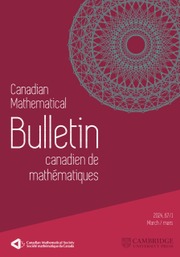Article contents
A New Class of Representations of EALA Coordinated by Quantum Tori in Two Variables
Published online by Cambridge University Press: 20 November 2018
Abstract
We study the representations of extended affine Lie algebras  $s{{\ell }_{\ell +1}}\left( {{\mathbb{C}}_{q}} \right)$ where
$s{{\ell }_{\ell +1}}\left( {{\mathbb{C}}_{q}} \right)$ where  $q$ is
$q$ is  $N$ -th primitive root of unity (
$N$ -th primitive root of unity (  $({{\mathbb{C}}_{q}}$ is the quantum torus in two variables). We first prove that
$({{\mathbb{C}}_{q}}$ is the quantum torus in two variables). We first prove that  $\oplus \,s{{\ell }_{\ell +1}}\left( \mathbb{C} \right)$ for a suitable number of copies is a quotient of
$\oplus \,s{{\ell }_{\ell +1}}\left( \mathbb{C} \right)$ for a suitable number of copies is a quotient of  $s{{\ell }_{\ell +1}}\left( {{\mathbb{C}}_{q}} \right)$ . Thus any finite dimensional irreducible module for
$s{{\ell }_{\ell +1}}\left( {{\mathbb{C}}_{q}} \right)$ . Thus any finite dimensional irreducible module for  $\oplus \,s{{\ell }_{\ell +1}}\left( \mathbb{C} \right)$ lifts to a representation of
$\oplus \,s{{\ell }_{\ell +1}}\left( \mathbb{C} \right)$ lifts to a representation of  $s{{\ell }_{\ell +1}}\left( {{\mathbb{C}}_{q}} \right)$ . Conversely, we prove that any finite dimensional irreducible module for
$s{{\ell }_{\ell +1}}\left( {{\mathbb{C}}_{q}} \right)$ . Conversely, we prove that any finite dimensional irreducible module for  $s{{\ell }_{\ell +1}}\left( {{\mathbb{C}}_{q}} \right)$ comes from above. We then construct modules for the extended affine Lie algebras
$s{{\ell }_{\ell +1}}\left( {{\mathbb{C}}_{q}} \right)$ comes from above. We then construct modules for the extended affine Lie algebras  $s{{\ell }_{\ell +1}}\left( {{\mathbb{C}}_{q}} \right)\oplus \mathbb{C}{{d}_{1}}\oplus \mathbb{C}{{d}_{2}}$ which is integrable and has finite dimensional weight spaces.
$s{{\ell }_{\ell +1}}\left( {{\mathbb{C}}_{q}} \right)\oplus \mathbb{C}{{d}_{1}}\oplus \mathbb{C}{{d}_{2}}$ which is integrable and has finite dimensional weight spaces.
Information
- Type
- Research Article
- Information
- Copyright
- Copyright © Canadian Mathematical Society 2002
References
- 5
- Cited by

